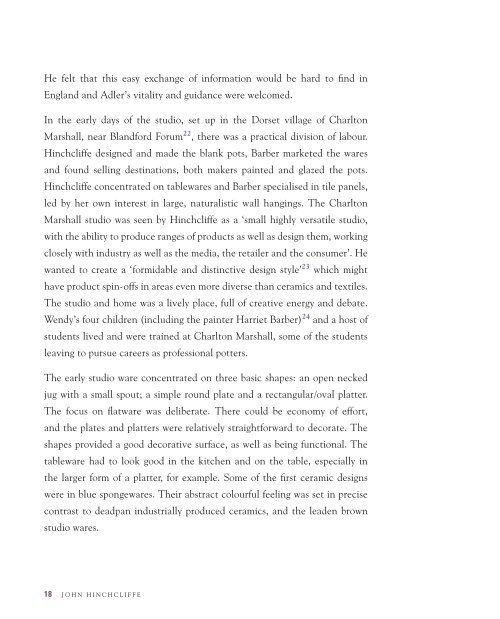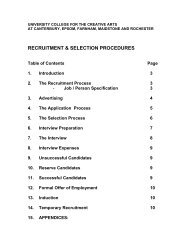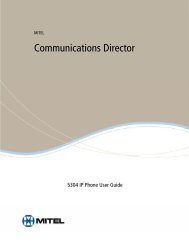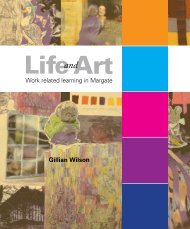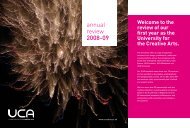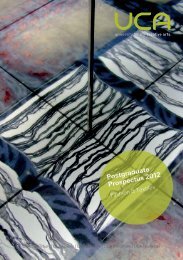John Hinchcliffe
John Hinchcliffe
John Hinchcliffe
- No tags were found...
You also want an ePaper? Increase the reach of your titles
YUMPU automatically turns print PDFs into web optimized ePapers that Google loves.
He felt that this easy exchange of information would be hard to find inEngland and Adler’s vitality and guidance were welcomed.In the early days of the studio, set up in the Dorset village of CharltonMarshall, near Blandford Forum 22 , there was a practical division of labour.<strong>Hinchcliffe</strong> designed and made the blank pots, Barber marketed the waresand found selling destinations, both makers painted and glazed the pots.<strong>Hinchcliffe</strong> concentrated on tablewares and Barber specialised in tile panels,led by her own interest in large, naturalistic wall hangings. The CharltonMarshall studio was seen by <strong>Hinchcliffe</strong> as a ‘small highly versatile studio,with the ability to produce ranges of products as well as design them, workingclosely with industry as well as the media, the retailer and the consumer’. Hewanted to create a ‘formidable and distinctive design style’ 23 which mighthave product spin-offs in areas even more diverse than ceramics and textiles.The studio and home was a lively place, full of creative energy and debate.Wendy’s four children (including the painter Harriet Barber) 24 and a host ofstudents lived and were trained at Charlton Marshall, some of the studentsleaving to pursue careers as professional potters.The early studio ware concentrated on three basic shapes: an open neckedjug with a small spout; a simple round plate and a rectangular/oval platter.The focus on flatware was deliberate. There could be economy of effort,and the plates and platters were relatively straightforward to decorate. Theshapes provided a good decorative surface, as well as being functional. Thetableware had to look good in the kitchen and on the table, especially inthe larger form of a platter, for example. Some of the first ceramic designswere in blue spongewares. Their abstract colourful feeling was set in precisecontrast to deadpan industrially produced ceramics, and the leaden brownstudio wares.This studio work had an attractive ‘velvet’ feel to it, directly attributable tothe maiolica technique (<strong>Hinchcliffe</strong> used the English Victorian derivation‘majolica’ to describe it). Biscuit fired earthenware is dipped into an opaquemaiolica or tin glaze which dries as a powdery surface rather like blotting paper.The decoration is then applied by directly sponging onto the surface, followedby a second firing to fix the glaze. The sponged decoration is therefore fusedwithin the glaze, applied directly, or through stencils designed and cut outby <strong>Hinchcliffe</strong>. Resist techniques were employed on the ceramics, drawingon <strong>Hinchcliffe</strong>’s experience of textile techniques. This first studio work wasinstantly successful. It looked unusual, dynamic and fresh, certainly as far asBritish tableware was concerned. In fact, the makers had first seen spongewarein America and ‘fallen in love with its primitive charm’. The work, sometimessimply in blue and white, sometimes with the addition of sponged decorationin dashes of red, green and yellow, was direct and cheerful. It sold instantly.Two public exhibitions of the ceramic work were particularly important inthese early days of the partnership (which was put on a more formal businessbasis in 1983). The first arose out of the offer made to <strong>Hinchcliffe</strong> in 1982 ofan exhibition at the craft shop in the Victoria & Albert Museum, London.<strong>Hinchcliffe</strong> - whose textile work already featured in the permanent collectionsthere - was originally asked to produce a show of his rag rugs and woven pieces,but he declined. Instead he embarked on a short-lived collaborative venturewith the potter Janice Tchalenko, whose coloured stoneware glazes he hadpreviously admired. 25 He wanted specifically to stretch his ceramic range. Hisapproach to Tchalenko was conceived as an artistic collaboration, a pooling ofskills, and satisfied a requirement on his part for his fellow maker’s technicalexpertise. The makers produced an impressive body of work (key examples ofwhich are now held in the Crafts Council’s permanent collection), revealingbold floral and fish designs (using sponging and stencilling). A deep blue and18 J o h n H i n c h c l i f f e J o h n H i n c h c l i f f e 19


